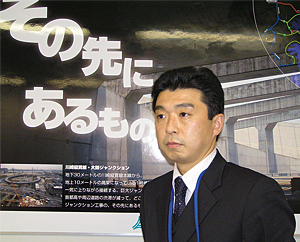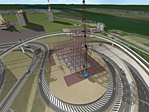Simulation of Traveling and Construction of Daishi JCT and Daishi Ventilation Station Demonstrated the Potential of Complex VR Representation of Buildings and Civil Engineering Structures
Metropolitan Expressway Co., Ltd. is committed as their mission to contributing to the realization of a rich and comfortable society through forming a safe and smooth expressway under the motto "Networking People, Communities, and Daily Lives." In compliance with the Law Concerning the Privatization of the Four Highway Public Corporation, which passed June 2004, Metropolitan Expressway Public Corporation, the predecessor of the Company, was restructured into a present organization on October 1st, 2005. This article focuses on "Design Group," established in Kanagawa Construction Bureau, and in particular, on how its members are addressing facilities building.
In Design Group, facilities staff, especially building-related staff has been using Forum8 "UC-win/Road" as a communication tool to be used, for example, in presentation. "UC-win/Road" was introduced with "Trans Kawasaki Route" project as motivation. In shaping up the project, they worked on creating 3D-VR (virtual reality) data to use as public information for the local residents and bidders. Then they arranged those data into a set of work entitled "Construction Simulation of Daishi Junction and Daishi Ventilation Station," submitting it to "the 5th 3D-VR Simulation Contest" held by Forum 8 on November 27, 2006. The following is an interview with Mr. Itaru Nakahara, Senior Member of Design Group, who took charge of a series of these works.
Metropolitan Expressway Public Corporation, a predecessor of Metropolitan Expressway Company Ltd. (the Company), was founded in 1959. Starting with the opening of Route No.1 with a 4.5km section between Kyobashi and Shibaura, it has been expanding Expressway network in succession, with the total length of 286.8km at present. Currently, construction is going on for 5 more routes (36km in total).
After almost a year and a half since its privatization, the Company operates various businesses including construction and management of parking lots and other facilities under overpasses, in addition to the construction, maintenance, and management of Metropolitan Expressway, which was taken over from the former Public Corporation. The Company has adopted the following 5 management principles: Customers first, Coexistence with local communities, Social responsibility, Autonomous management, and A vibrant work environment for employees. To achieve these, the Company has its head office situated in Chiyoda-ward, Tokyo, with 2 Construction Bureaus (Shinjuku-ward and Yokohama-city), and 3 Operation Bureaus (Chiyoda-ward, Chuo-ward, and Yokohama-city). 1,200 employees are stationed in these offices.
Based on this structure, Kanagawa Construction Bureau covers construction projects of expressways in Yokohama and Kawasaki areas. Currently, it is responsible for 3 project routes, namely, "Yokohama Circular Northern Route," "Trans Kawasaki Route," and "Ishikawa-cho Off-ramp."
"Among these, I am in charge of "Trans Kawasaki Route," says Mr. Nakahara. He belongs to Design Group in Kanagawa Construction Bureau, which consists of civil-engineering related staff (8), and facility-related staff (8), amounting to 16 in all. Facility-related staff can be further divided into building-related (3), machinery-related (2), and electricity-related (3). Mr. Itaru Nakahara specializes in facility building, getting involved in design and supervision of building structures such as ventilation facilities and tollbooths, which are essential for the operation of expressways.
"Trans Kawasaki Route" is a project of about 7.9km extending east to west along National Highway Route 409. It originates from Fujimi On/Off-ramp where it connects with National Highway Route 15, and ends at Kawasaki-Ukishima Junction which links to Bay Shore (Wangan) Route and to Tokyo Wan Aqua-Line. On the way along the route is placed Daishi Junction, connecting with Yokohane Line of Kanagawa Route No.1.
Originally positioned as one of the business core cities, which should be a center in a fairly wide area, City of Kawasaki has been required to enhance its networking function as a base for cooperation to cover broader area, as well as to mitigate traffic jam and to improve residential environment. For this reason, Trans Kawasaki Route has realized unification with several trunk roads to cover wide area as a whole. With regard to road structure, it has adopted overpass structure in exclusive industrial zone, while adopting ditch or underground structure. Along with the latter, it is planned to install 2 ventilation stations (Suzukicho Ventilation Station and Daishi Ventilation Station).
In 2002, an overpass section between Kawasaki-Ukishima JCT and Tonomachi started operation in advance. The remainder tunnel section is now under construction by means of the "Multi Micro Shield Tunneling (MMST) method." This is a new tunneling method through constructing outer shells with several small shield machines, linking those shells, and excavating the ground inside to make a tunnel. Compared with an ordinary open-cut method, this method is supposed to have merits such as being able to mitigate negative influences on the surrounding environment during construction.
In the end of January this year, a contract was concluded on the construction of "Daishi Ventilation Station." Works have already started on February 1st. "With regard to Daishi Ventilation Station, we, Design Group, is performing supervision of the works as well as its design," explains Mr. Itaru Nakahara on the present conditions of Trans Kawasaki Route. He serves as a supervisor at the site of the ventilation station.
 |
|
 |
|
 |
|
 |
 |
"Construction Simulation of Daishi Junction and Daishi Ventilation Station" By Kanagawa Construction Bureau, Metropolitan Expressway Co., Ltd. |
|
In fact, he's been temporally transferred to Tokyo Metropolitan Government for 2 years. First from April 2002 through January 2003, he was in charge of category II urban redevelopment project of Kita-Shinjuku area in Redevelopment Division, Urban Development and Improvement Department, Construction Bureau. Next, he was transferred to Planning Division, Urban Development and Improvement Department, Bureau of Urban Development. As a Section Chief in charge of building in Ohashi area, he was engaged in category II urban redevelopment project of Ohashi area.
Both projects were aiming at intensive use of land and renewal of urban functions through improving traffic infrastructure and the surrounding zones as a whole. Especially in the latter project, it was required to draw a city plan in a short time period. Thus, it was positioned as a big challenge how to smoothly gain the understanding of residents, "Ohashi 1-Chome area redevelopment Council," consisted of landowners and leaseholders. At that time, he used common presentation tools and perspective drawings only. However, he thought, "Only a relationship of trust is left to work finally," and realized the importance of presenting images as detailed as possible in advance to build such a relationship.
"It is a basic stance of facility-building-related staff to make the best use of construction IT (information technology) for which a variety of outstanding technology has been developed," Mr. Nakahara says.
Based on his experience in Tokyo Metropolitan Government, he focused on the fact that common images can be shared with each other by making a visual appeal, rather than using traditional words and 2D drawings, e.g. in building consensus. This led them to introduce "UC-win/Road" as a tool to assist planning and examination, in addition to CAD, presentation software, image processing software, and modeling software, as Mr. Nakahara recalls.
On the other hand, there is a shared folder with mass storage in Kanagawa Construction Bureau to make an effective use of an enormous amount of CAD and photo data possessed by Design Group. In that folder, photo (image) data are classified systematically according to their properties like objects or time series. "In the case of Daishi Ventilation Station, it has been changing its color and shape at different stages of examination. We can search for particular data that show what it looked like at which year within a framework of time series," Mr. Nakahara says.
As a mechanism to promote improvement in business management, Design Group has adopted a "team system" since September 2005, prior to privatization. In this system, a team consists of plural members with a senior member designated as a "leader." Usually, each team manages projects and makes a monthly report to a general manager on its activity. Teams are formed at any time depending on different tasks. At present, 16 staff members in total belong to 18 teams. Serving as a leader of "Team for Daishi Ventilation Station" and "Team for Improvement" for himself, Mr. Nakahara also takes part in other teams as a member. "Team for Improvement," in particular, aims at improving work environment, promoting to establish rules for easier use of the above-mentioned shared folder.
"We created construction simulation of Daishi Ventilation Station in order for the neighboring residents to visually understand a flow of a series of construction works in a digest."
In June 2004, after coming back from Tokyo Metropolitan Government where he had been temporally transferred, Mr. Itaru Nakahara took charge of Yokohama Circular Northern Route concurrently with Trans Kawasaki Route. At that time, he took notice of the effectiveness of the method using "UC-win/Road," which he took over from his predecessor. This course of events led the team responsible for Daishi JCT to adopt "UC-win/Road" as a tool for presentation for both traffic managers and local residents.
In addition to being in a residential area, the portion of Trans Kawasaki Route within the concerned area is close to Heikenji Temple (commonly known by "Kawasaki Daishi," founded in 1128). The construction sites of Daishi JCT and Ventilation Station in particular were on the river fringe of the Tama River where it is supposed that a wooden statue, a principal image in the Temple, had been recovered from the water (the place-name of "Daishigawara" originates in the story). For this reason and others, it was required to give adequate considerations not only to landscape as a matter of course, but also to the influence on the surrounding environment associated with construction work. Thus, meetings of liaison council for 9 towns were held at appropriate time depending on progress of the project, as an opportunity for communicating with the local people from an early stage. In addition, in preparation for in-depth question and answer sessions, a set of 3D-VR data was created so that everyone can recognize construction scenes with ease. In effect, they fihished their presentation sucessfully without using VR data, partly because the color of Daishi Ventilation Station was similar to that of the oratory for automobile traffic safety attached to Kawasaki Daishi.
These VR data, however, brought about an unexpected secondary merit. After its privatization, the Company had been promoting implementation of "Price Negotiation Method based on Technical Proposal" as a new method of price negotiation in ordering construction works. This means to determine a successful bidder through a competitive tender bid after receiving technical proposals from, and price negotiation with, plural bidders at the same time. When the construction work of Daishi Ventilation Station was decided to be the first trial case of the above method among works for the facility technology division, there was yet room for originality and ingenuity in detailed procedures, as Mr. Nakahara says.
Then, this construction simulation was utilized so that bidder companies could prepare technical proposals, grasping the site location and the designer's intention as well as challenges and points to note concerning construction equally, and accurately.
Mr. Nakahara positioned 3D-VR as a very effective tool for consensus building and presentation, and mentioned its diverse potential. Based on this, he advocates the significance of using "UC-win/Road," which is originally software for assisting road design, for a construction matter this time.
In other words, he assumes a need to reproduce a world in more detailed manner, simulating the reality. He presents the idea that each of the buildings and civil engineering structures in there should not be seen as a single item, but rather be viewed on a common field of an urban city as a whole. "In this sense, I've got a strong feeling from this attempt that we can adequately respond to even higher needs."
We are most grateful to everyone involved for spending time with us for the interview.


